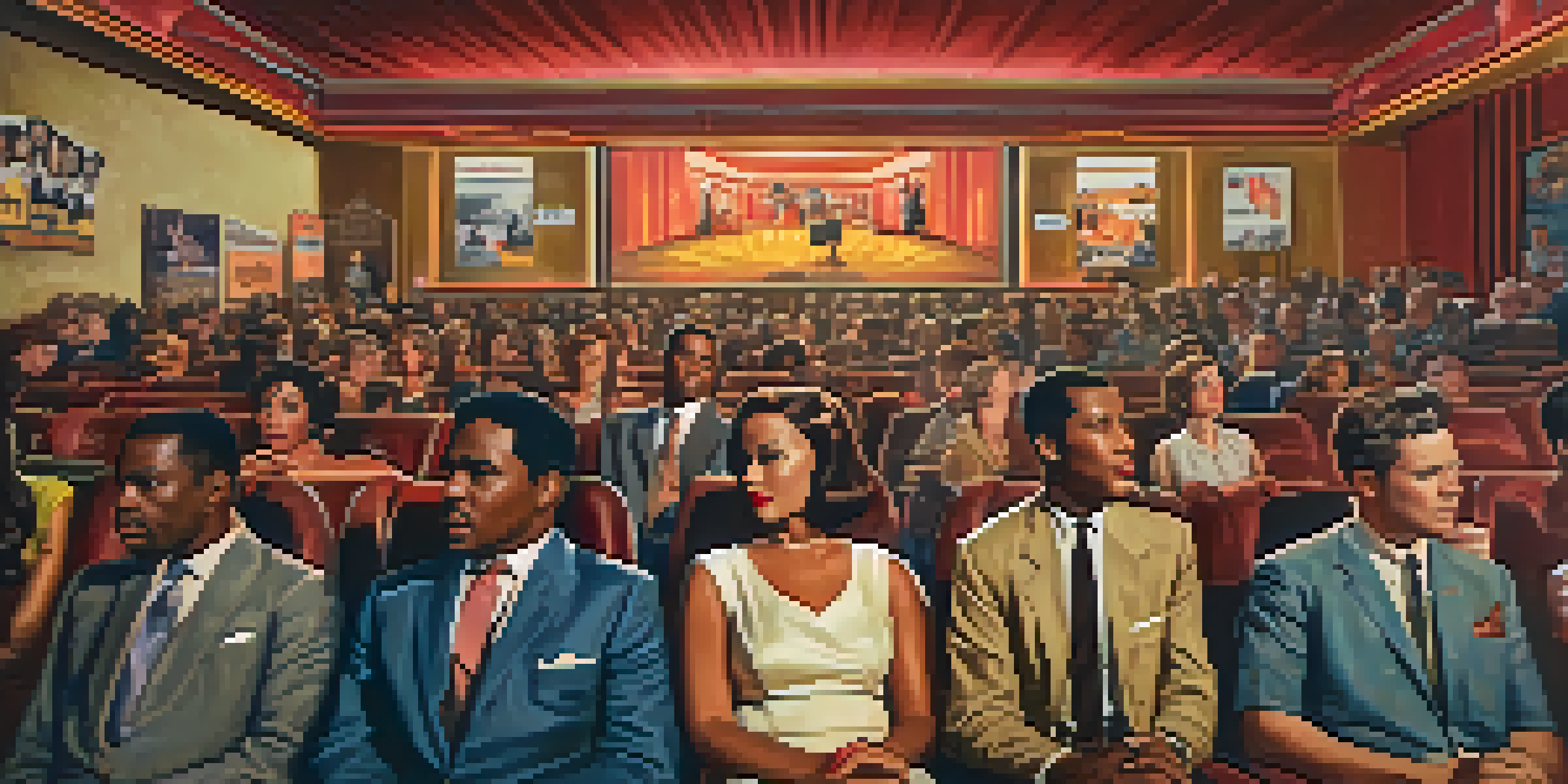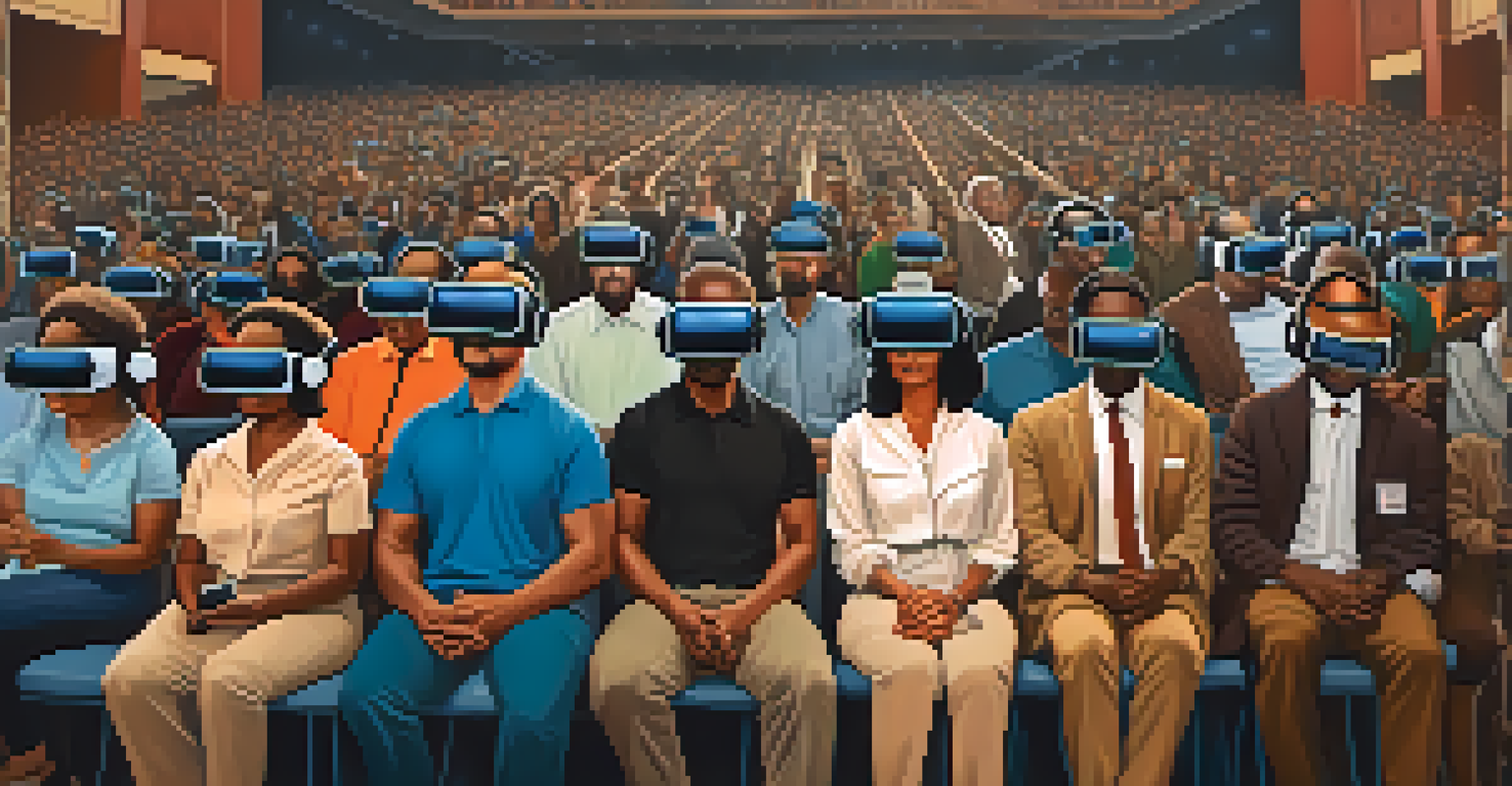Cinema and Civil Rights: A Historical Perspective in Film

The Birth of Film and Its Social Context
The inception of cinema in the late 19th century coincided with significant social changes. As the world transitioned into the 20th century, issues such as race relations and women's suffrage began to take center stage. Early films often mirrored societal norms, but they also became a medium for challenging the status quo. This dual role of cinema set the stage for its involvement in civil rights discussions.
Cinema is a matter of what's in the frame and what's out.
For instance, films like 'The Birth of a Nation' (1915) showcased racial stereotypes, which sparked significant backlash. This prompted filmmakers and activists alike to recognize the power of film as a tool for both oppression and liberation. As audiences became more aware of these representations, the potential for cinema to influence public perception and policy became evident.
Thus, the early years of cinema laid a complex foundation, where entertainment and socio-political commentary intertwined. This initial relationship foreshadowed the pivotal role that film would play in shaping civil rights narratives in the decades to come.
Hollywood's Response to Civil Rights Movements
As the civil rights movement gained momentum in the 1950s and 1960s, Hollywood began to respond, albeit slowly. Films like 'Guess Who's Coming to Dinner' (1967) tackled interracial relationships, opening up dialogues around race that had been largely silenced. These narratives not only entertained audiences but also offered a reflection of the changing societal attitudes towards race and equality.

However, the portrayal of civil rights issues in film often struggled with authenticity. Many productions were critiqued for glossing over the harsh realities faced by activists. This disconnect highlighted a crucial need for filmmakers to engage more deeply with the actual stories and experiences of those involved in the struggle for civil rights.
Cinema's Role in Social Change
From its inception, film has mirrored societal norms while also challenging them, becoming a powerful tool in civil rights discussions.
Despite its limitations, this era marked a turning point in cinema, as filmmakers began to recognize their responsibility to portray the complexities of social justice. The dialogue between Hollywood and civil rights advocates started to evolve, paving the way for more nuanced storytelling.
Documentaries: Capturing Real Struggles
The rise of documentary filmmaking in the latter half of the 20th century offered a powerful platform for civil rights activism. Documentaries like 'Freedom on My Mind' (1994) provided raw, unfiltered insights into the struggles faced by activists. By presenting real-life footage and interviews, these films humanized the movement, allowing audiences to grasp the urgency and importance of the fight for equality.
The power of film is that it can change the way we see the world.
These documentaries often served as historical records that preserved the voices of those who fought for civil rights. They not only educated viewers but also inspired future generations to continue the work of their predecessors. The impact of such films is still felt today, as they contribute to ongoing conversations about race and justice.
In essence, documentaries bridged the gap between entertainment and activism, proving that cinema could be a catalyst for change. By showcasing the realities of civil rights struggles, these films helped to shape public understanding and empathy.
Iconic Films that Changed Perceptions
Certain films have transcended their entertainment value to become cultural milestones in the civil rights narrative. 'Selma' (2014) is a prime example, as it depicts the historic march from Selma to Montgomery, highlighting the courage and resilience of activists. Such films not only recount historical events but also inspire discussions about the ongoing fight for equality.
Moreover, these iconic films often spark renewed interest in the historical context of civil rights movements. Viewers are encouraged to explore the stories behind the characters, leading to a deeper understanding of the societal challenges faced. This connection between cinema and education fosters a cultural awareness that extends beyond the screen.
Documentaries Amplify Voices
Documentaries provide unfiltered insights into civil rights struggles, preserving the voices of activists and educating audiences.
Ultimately, films that encapsulate civil rights themes serve as powerful reminders of the past. They encourage audiences to reflect on the progress made and the work that still lies ahead in the quest for justice.
The Role of Independent Filmmakers
Independent filmmakers have played a crucial role in amplifying marginalized voices within the civil rights narrative. Unlike mainstream studios, indies often have the freedom to explore complex themes without commercial constraints. Films like '13th' (2016) delve into the historical roots of systemic racism and mass incarceration, challenging viewers to confront uncomfortable truths.
These independent productions often prioritize authenticity and representation, showcasing stories that might otherwise be overlooked. By focusing on personal narratives and community experiences, they create a more diverse cinematic landscape that reflects the complexities of civil rights issues. This grassroots approach can resonate deeply with audiences, leading to greater empathy and understanding.
In this way, independent cinema acts as a vital counterbalance to mainstream narratives. It not only enriches the discourse surrounding civil rights but also empowers communities to share their own stories, fostering a more inclusive dialogue.
Modern Cinema: Continuing the Conversation
Today, cinema continues to be a powerful platform for discussing civil rights and social justice. Films like 'Black Panther' (2018) not only entertain but also celebrate Black culture, challenging stereotypes in a mainstream context. Such movies create space for dialogue around representation and the ongoing fight for equality, making them significant in the current cultural landscape.
Moreover, streaming platforms have democratized access to diverse stories, allowing filmmakers from various backgrounds to share their perspectives. This shift has led to an increase in content that addresses civil rights issues, ensuring that these vital conversations remain at the forefront of popular culture. From documentaries to narrative features, modern cinema reflects a broader array of experiences and voices.
Future of Film and Representation
The evolving landscape of cinema, driven by diverse voices and new technologies, offers opportunities for authentic storytelling in civil rights.
As we move forward, it is essential for filmmakers to continue this legacy of engagement. By tackling contemporary civil rights challenges through the lens of cinema, they can inspire new generations to participate in the ongoing struggle for justice.
The Future of Film and Civil Rights
Looking ahead, the relationship between cinema and civil rights appears poised for further evolution. As societal challenges persist, filmmakers have an opportunity to address these issues directly through their work. The increasing diversity behind the camera, with more directors and writers from underrepresented communities, signals a positive shift towards more authentic storytelling.
Moreover, emerging technologies like virtual reality and interactive storytelling could transform how audiences engage with civil rights narratives. These innovations offer immersive experiences that can foster empathy and understanding, allowing viewers to step into the shoes of those affected by social injustices. This could revolutionize the way stories are told and experienced.

Ultimately, the future of film in relation to civil rights will hinge on the commitment to authenticity, representation, and social responsibility. As cinema continues to reflect and shape societal values, filmmakers have a unique responsibility to use their platform for good, inspiring change and fostering dialogue.